Click on images to enlarge

infestation (Photo: Sheldon Navie)

habit in flower (Photo: Sheldon Navie)
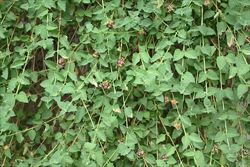
habit in fruit (Photo: Sheldon Navie)

slender creeping stems and leaves (Photo: Sheldon Navie)
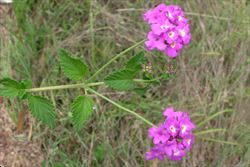
flower clusters in the forks of the paired leaves (Photo: Sheldon Navie)

close-up of flowers with white and yellow centres (Photo: Sheldon Navie)
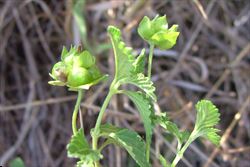
close-up of immature fruit (Photo: Sheldon Navie)
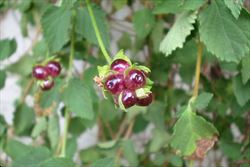
close-up of mature fruit (Photo: Sheldon Navie)
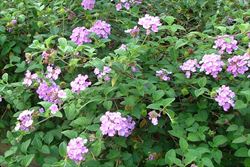
habit of sterile ornamental form (Photo: Sheldon Navie)

close-up of sterile ornamental form, showing lack of fruit (Photo: Sheldon Navie)
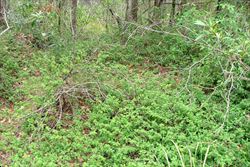
sterile ornamental form invading bushland (Photo: Sheldon Navie)
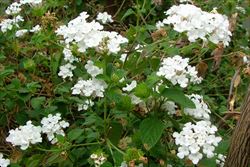
white-flowered sterile ornamental form (Photo: Sheldon Navie)

yellow-flowered sterile hybrid, involving Lantana camara and Lantana montevidensis (Photo: Sheldon Navie)
Scientific Name
Lantana montevidensis (Spreng.) Briq.
Synonyms
Lippia montevidensis Spreng.Lantana sellowiana Link & Otto
Family
Verbenaceae
Common Names
creeping lantana, purple lantana, Sellow's lantana, small lantana, trailing lantana, trailing shrubverbena, weeping lantana, wild verbena
Origin
Native to South America (i.e. Bolivia, Uruguay, Paraguay, Argentina and southern Brazil).
Cultivation
This species has been widely cultivated as a garden ornamental. Various modern cultivars and hybrids, which are often sterile, are still planted as groundcovers in gardens. The most commonly seen include lilac-coloured and white-coloured cultivars that are similar to the typical form of the species, except that they are sterile. Sterile cultivars with golden-yellow flowers are also common, but these are actually hybrids involving Lantana montevidensis and Lantana camara . These hybrids are usually named after one of the two parent species (e.g. Lantana montevidensis 'Pot of Gold' and Lantana camara 'New Gold').
Naturalised Distribution
This species is widely naturalised in eastern Australia (i.e. in eastern Queensland and some parts of eastern New South Wales). It is most common and widespread in the coastal and sub-coastal districts of south-eastern and central Queensland. Possibly also naturalised in the Northern Territory.
Also naturalised in many other parts of the world, including New Zealand, Hawaii, New Caledonia and southern USA (i.e. California, Texas, Louisiana, Alabama, Georgia and Florida).
Habitat
Largely found in tropical and sub-tropical environments, and occasionally also in temperate and semi-arid regions. Primarily a weed of pastures, open woodlands, hillsides, railways, roadsides, embankments, disturbed sites and waste areas.
Habit
A low-growing (i.e. prostrate or decumbent), long-lived (i.e. perennial), shrubby plant with a creeping, trailing or scrambling habit.
Distinguishing Features
- a low-growing, long-lived, shrubby plant forming dense mats of vegetation over the ground.
- its leaves are borne in pairs along the slender, unarmed, creeping stems.
- its small tubular flowers are borne in compact clusters (1-4 cm across).
- these flowers (8-12 mm long and 4-8 mm across) are usually pink, mauve or purple with a white or yellowish coloured throat.
- its reddish-purple to purple 'berries' are 6-8 mm across and contain a single hard seed.
Stems and Leaves
The slender stems (1-2 mm thick) are four-angled (i.e. quadrangular) at first, but become woody (about 5 mm thick) and more or less cylindrical as they mature. These stems grow to about 1 m long and form dense mats over the ground surface. They sometimes also produce roots at their joints (i.e. nodes) where they come into contact with the soil.
The leaves are oppositely arranged and are borne on short stalks (i.e. petioles) 2-4 mm long. These leaves (8-40 mm long and 5-25 mm wide) are egg-shaped in outline (i.e. ovate) with finely toothed (i.e. crenate or serrate) margins. Their upper surfaces are rough to the touch (i.e. scabrous), while their undersides are softly hairy (i.e. pubescent).
Flowers and Fruit
The small tubular flowers (8-12 mm long and 4-8 mm across) are borne in dense clusters (1-4 cm across). The flowers on the outer edges of these clusters open first, with the others opening successively inwards. Individual flowers are borne on short stalks (i.e. pedicels) all originating from the same point at the top of a longer flowering stem (i.e. peduncle) 2-8 cm long. The flowers are initially pink, mauve or pale purple with a white or yellowish coloured throat. As they age they change colour slightly, generally become entirely purple. Flowering occurs throughout most of the year.
The fruit is a single-seeded fleshy 'berry' (i.e. drupe). These fruit (6-8 mm across) are green at first and turn pinkish, reddish-purple or purplish in colour as they mature. The pale seeds are stony and about 4 mm long.
Note: some garden cultivars of this species do not produce fruit.
Reproduction and Dispersal
This plant reproduces by seed, which are dispersed when the fleshy fruit are eaten by birds and other animals. It also spreads across the ground laterally, occasionally rooting at the stem joints (i.e. nodes). Seeds and stem segments are occasionally dispersed in dumped garden waste.
Environmental Impact
Creeping lantana (Lantana montevidensis) is regarded as a significant environmental weed Queensland and as an environmental weed in New South Wales. It was also recently listed as a priority environmental weed in at least one Natural Resource Management region.
Other Impacts
Legislation
This species is declared under legislation in the following states and territories:
- Queensland: Class 3 - this species is primarily an environmental weed and a pest control notice may be issued for land that is, or is adjacent to, an environmentally significant area (throughout the entire state). It is also illegal to sell a declared plant or its seed in this state. This declaration applies to all lantana species (Lantana spp.).
- New South Wales: Class 3 - a regionally controlled weed. The relevant local control authority must be promptly notified of the presence of this weed and it must be fully and continuously suppressed and destroyed (in the Bega Valley, Eurobodalla and Lord Howe Island local authority areas). Class 4 - a locally controlled weed. The growth and spread of this species must be controlled according to the measures specified in a management plan published by the local control authority and the plant may not be sold, propagated or knowingly distributed (in a large number of local authority areas). Class 5 - a restricted weed which must not be sold, bought or knowingly distributed (throughout the entire state). See the New South Wales Department of Primary Industries Noxious Weeds List at http://www.dpi.nsw.gov.au for more detailed information on which local areas are covered in these declarations. This declaration applies to all lantana species (Lantana spp.).
- Northern Territory: B - growth and spread of this species to be controlled (in areas outside of towns), and C - not to be introduced into the Territory.
- Western Australia: Prohibited - on the prohibited species list and not permitted entry into the state.
Management
For information on the management of this species see the following resources:
- the Biosecurity Queensland Fact Sheet on this species, which is available online at http://www.dpi.qld.gov.au.
- the Northern Territory Department of Natural Resources, Environment and The Arts Agnote on this species, which is available online at http://www.nt.gov.au/weeds.
Similar Species
Creeping lantana (Lantana montevidensis) is relatively similar to lantana (Lantana camara). However, lantana (Lantana camara) it a much taller plant with a more upright (i.e. erect) growth habit and usually has prickles or thorns along its stems.

